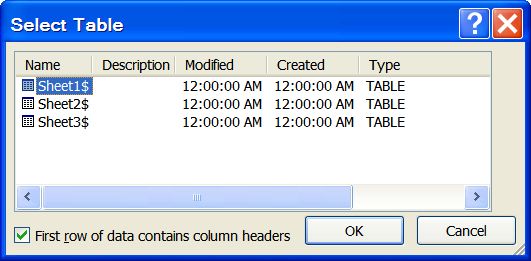 I’m always happy to write about Zoho. It’s an amazing company that’s run by an amazing entrepreneur I’d love to meet one day. And the company is like an iceberg. The tip you see in the US is very small, but the the company has a big, competent, and productive staff in India.
I’m always happy to write about Zoho. It’s an amazing company that’s run by an amazing entrepreneur I’d love to meet one day. And the company is like an iceberg. The tip you see in the US is very small, but the the company has a big, competent, and productive staff in India.
Before I write about Zoho Meeting, I’d like to reiterate an earlier post about Zoho support. I’m doing this because Zoho’s approach should be studied by others; it should be their model for what support should be. Even though most of their software is free for small business use, Zoho always answers support emails, and even feedback emails where you can suggest things they can do to improve their software. Contrast that with what you’re used to at Amazon, which for years hid their contact information so you couldn’t complain about an order done wrong. Or LinkedIn, where I had to write to Reid Hoffman before I got an answer to a support question.
First, let’s discuss the problem this service resolves. If you’re demonstrating a product or service, it’s much more efficient to speak to several people at the same time – from one location. That may not work with vacuum cleaners, but it does for software and software services, because people judge these by what they see on the screen. As an example, Jason Alba recently did a presentation to over 200 people about social networking.
If you’re going to talk to large groups, GoToWebinar is still the gold standard (for me – but I haven’t yet tried WebEx or Windows Live Meeting). But GTW costs $100/month. If you’re going to do one-on-one meetings, you can use Zoho Meeting at no charge!
Here’s that pesky question again: why?
Some possible uses:
- You want to give somebody a sales pitch, and they’re not local.
- You want to show somebody who’s not local how to do something on your computer.
- You want to show your mother how to open her emails.
- Somebody found out you know a lot about computers and they want you to fix their computer – but they live 500 miles away.
- You’re working with a team member on a project, and you both need to see the same screen.
How do you use Zoho Meeting?
First thing I like: you can sign on through your Google or Yahoo account. At long last, a company without an ego. They actually realize that Google and Yahoo have more members than they do! And apparently, it doesn’t bother them! Wow! So go to meeting.zoho.com and use your Google ID to sign in. That will bring up a screen from the Google server asking if it’s ok, and if you want Google to remember Zoho as a site you want to use in the future. Once you’re logged in, you’ll get a screen like this – pretty easy to understand!
I’m not going to do a tutorial on this, at least not now, but if you’ve ever done webinars before, or if you just want to try one, give this a shot. It’s easy to set up a meeting and invite somebody to join. You’ll have to download some software, and so will your participant, but it’s not too obnoxious. And then, when the participant joins the meeting, they have a choice of 3 clients for their browser, Java, ActiveX, or Flash. I’ve tested all the combinations, and I think Flash is the easy winner, so try that first. I’ve also tested with Firefox, Internet Explorer, and Chrome – they all work fine.
As you’d hope, Zoho Meeting takes care of resizing the desktop to resolve any conflicts. For example, my host, with 24″ screen, works fine with my participant machine, a laptop with 15″ screen. But you will find that the Flash client works best for different screen sizes.
Whatever you do on your host computer is shown with minimal delays on the participant computer. So it’s easy to do a slideshow, or go through a document or process on your computer.
So far so good, we have video, Houston.
But what about sound? Given today’s technology, I recommend phones for the audio portion, and Zoho provides a service similar to freeconferencecall.com with the video conferencing (this is free, but the call is a toll call – not a problem for participants with unlimtied calling).
Most services also support VoIP. I don’t recommend that, because if your participant doesn’t have headphones, you can get a lot of echoing, which may make the audio unusable. But you may want to try it for yourself, especially if the phone call costs your participant real money. The VoIP call is free even if they’re in Budapest.
If you need to do bigger webinars, Zoho currently supports up to 25 users, and that limit will be increased in the future – I know that because they answered my suggestion email! And this is a company with an amazing track record of really delivering what they promise. The larger sessions will cost you, but the charge is much lower than GTW, and from what I can see the service, while not as feature-rich, is just as good from the perspective of usability and speed.
A final word about Zoho: I managed many software products – word processing, spreadsheet, graphics, and database (and probably others I’ve forgotten). Unfortunately for me, that world went away – Microsoft put everyone else out of business. There’s no WordStar or SuperCalc or you name it to compete with MS products any more – and too bad for the world. And then comes along this unknown (not so much anymore…) company with people who have strange names, and they actually make damn good products that can compete with MS. Terrific word processor, spreadsheet, CRM, and so much more. The sheer volume of their development scope and speed is inspiring. To me, this is the real shock and awe!
Hey, here’s another thought: if you’re out of work and you can’t afford Microsoft monopoly prices, you can write your resume with Zoho Writer. Use Zoho Sheet for your budget, etc. etc. You can do this from library computers, which are widely available, at least in my area. Send your resume using Zoho mail (or GMail – see this blog post about why they are the best), and then keep track of your job search using Zoho CRM or use JibberJobber.com.
 Thank you Sridhar Vembu, Zoho founder, for showing us how we used to do things before Microsoft ate everyone. BTW, he’s a brilliant blogger. Here’s an example, where he shows very concisely why Amazon can offer cloud computing at far lower margins than Google or Microsoft. Pretty obvious after reading the article. Sridhar’s normal blogging location is blogs.zoho.com/author/sridhar.
Thank you Sridhar Vembu, Zoho founder, for showing us how we used to do things before Microsoft ate everyone. BTW, he’s a brilliant blogger. Here’s an example, where he shows very concisely why Amazon can offer cloud computing at far lower margins than Google or Microsoft. Pretty obvious after reading the article. Sridhar’s normal blogging location is blogs.zoho.com/author/sridhar.




 I like to put all my contacts in Excel or Access, although you can do this mail merge from you Outlook contacts as well. The latest version of Excel (2007) has a nifty “dedupe” function that lets you weed out duplicate entries in your contact list. I’ve been waiting for that since the late 80s when I did my first direct mail.
I like to put all my contacts in Excel or Access, although you can do this mail merge from you Outlook contacts as well. The latest version of Excel (2007) has a nifty “dedupe” function that lets you weed out duplicate entries in your contact list. I’ve been waiting for that since the late 80s when I did my first direct mail.





 I’ve done dozens of presentations for job support groups. That’s how I got into this whole personal branding thing.
I’ve done dozens of presentations for job support groups. That’s how I got into this whole personal branding thing. Let’s take this out of the current domain. I used this exact principal consistently in my career. Whenever I went into a business venture with another company it was always based on what I could offer in exchange. The basis of any good deal is that both sides benefit – ask any top sales person if you don’t believe me.
Let’s take this out of the current domain. I used this exact principal consistently in my career. Whenever I went into a business venture with another company it was always based on what I could offer in exchange. The basis of any good deal is that both sides benefit – ask any top sales person if you don’t believe me.




 Next is this screen, which lets you do limited cropping. Since you won’t have to crop the picture, press Save the photo. And that’s it – you’ll have your beautiful new mug shot on your LinkedIn profile.
Next is this screen, which lets you do limited cropping. Since you won’t have to crop the picture, press Save the photo. And that’s it – you’ll have your beautiful new mug shot on your LinkedIn profile.

 I don’t believe much in touchy-feely motivational stuff, and I really squirm in my chair when a speaker makes you yell stuff out loud. That’s not to say I don’t believe in the concept, though. I just think that as an adult, it’s your responsibility to motivate yourself.
I don’t believe much in touchy-feely motivational stuff, and I really squirm in my chair when a speaker makes you yell stuff out loud. That’s not to say I don’t believe in the concept, though. I just think that as an adult, it’s your responsibility to motivate yourself.




Recent Comments